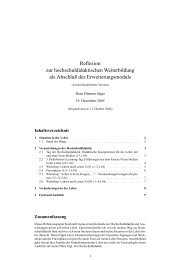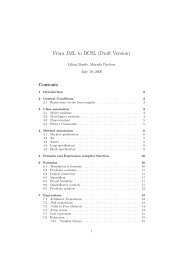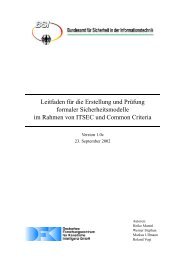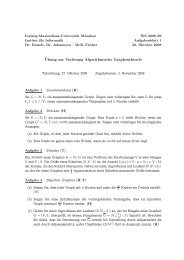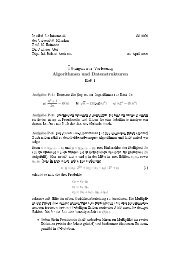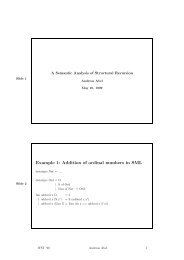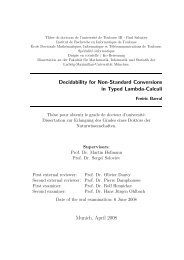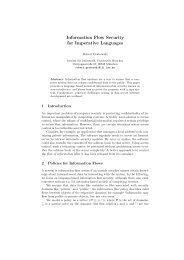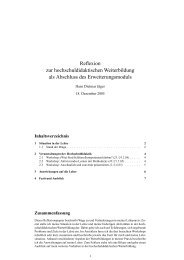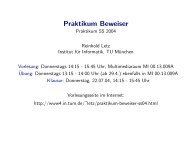Sorting the Slow Way: An Analysis of Perversely Awful ... - LMU
Sorting the Slow Way: An Analysis of Perversely Awful ... - LMU
Sorting the Slow Way: An Analysis of Perversely Awful ... - LMU
- No tags were found...
Create successful ePaper yourself
Turn your PDF publications into a flip-book with our unique Google optimized e-Paper software.
<strong>Sorting</strong> <strong>the</strong> <strong>Slow</strong> <strong>Way</strong>: <strong>An</strong> <strong>An</strong>alysis <strong>of</strong> <strong>Perversely</strong> <strong>Awful</strong><br />
Randomized <strong>Sorting</strong> Algorithms<br />
Hermann Gruber 1 and Markus Holzer 2 and Oliver Ruepp 2<br />
1 Institut für Informatik, Ludwig-Maximilians-Universität München,<br />
Oettingenstraße 67, D-80538 München, Germany<br />
email: gruberh@tcs.ifi.lmu.de<br />
2 Institut für Informatik, Technische Universität München,<br />
Boltzmannstraße 3, D-85748 Garching bei München, Germany<br />
email: holzer@in.tum.de<br />
Abstract. This paper is devoted to <strong>the</strong> “Discovery <strong>of</strong> <strong>Slow</strong>ness.” The archetypical<br />
perversely awful algorithm bogo-sort is analyzed with elementary methods. Moreover,<br />
practical experiments are performed.<br />
1 Introduction<br />
To our knowledge, <strong>the</strong> analysis <strong>of</strong> perversely awful algorithms can be tracked back at least<br />
to <strong>the</strong> seminal paper on pessimal algorithm design in 1984 [1]. But what’s a perversely awful<br />
algorithm In <strong>the</strong> “The New Hacker’s Dictionary” [6] one finds <strong>the</strong> following entry:<br />
bogo-sort: /boh‘goh-sort’/ /n./ (var. ‘stupid-sort’) The archetypical perversely awful<br />
algorithm (as opposed to ➞ bubble sort, which is merely <strong>the</strong> generic *bad*<br />
algorithm). Bogo-sort is equivalent to repeatedly throwing a deck <strong>of</strong> cards in <strong>the</strong> air,<br />
picking <strong>the</strong>m up at random, and <strong>the</strong>n testing whe<strong>the</strong>r <strong>the</strong>y are in order. It serves as a<br />
sort <strong>of</strong> canonical example <strong>of</strong> awfulness. Looking at a program and seeing a dumb algorithm,<br />
one might say ”Oh, I see, this program uses bogo-sort.” Compare ➞ bogus,<br />
➞ brute force, ➞ Lasherism.<br />
Among o<strong>the</strong>r solutions, <strong>the</strong> formerly mentioned work contains a remarkably slow sorting<br />
algorithm named slowsort achieving running time Ω ( n log n/(2+ǫ)) even in <strong>the</strong> best case. But<br />
<strong>the</strong> running time, still being sub-exponential, does not improve (i.e., increase) in <strong>the</strong> average<br />
case, and not even in <strong>the</strong> worst case. On <strong>the</strong> contrary, <strong>the</strong> analysis <strong>of</strong> bogo-sort carried out<br />
here shows that this algorithm, while having best-case expected running time as low as O(n),<br />
achieves an asymptotic expected running time as high as Ω(n · n!) already in <strong>the</strong> average case.<br />
The pseudo code <strong>of</strong> bogo-sort reads as follows:<br />
Algorithm 1 Bogo-sort<br />
1: Input array a[1 . . . n]<br />
2: while a[1 . . . n] is not sorted do<br />
3: randomly permute a[1 . . . n]<br />
4: end while<br />
The test whe<strong>the</strong>r <strong>the</strong> array is sorted as well as <strong>the</strong> permutation <strong>of</strong> <strong>the</strong> array have to be<br />
programmed with some care:
1: procedure sorted: {returns true if<br />
<strong>the</strong> array is sorted and false o<strong>the</strong>rwise}<br />
2: for i = 1 to n − 1 do<br />
3: if a[i] > a[i + 1] <strong>the</strong>n<br />
4: return false<br />
5: end if<br />
6: end for<br />
7: return true<br />
8: end procedure<br />
1: procedure randomly permute:<br />
{permutes <strong>the</strong> array}<br />
2: for i = 1 to n − 1 do<br />
3: j := rand[i . . . n]<br />
4: swap a[i] and a[j]<br />
5: end for<br />
6: end procedure<br />
The second algorithm is found, e.g., in [4, p.139]. Hence <strong>the</strong> random permutation is done<br />
quickly by a single loop, where rand gives a random value in <strong>the</strong> specified range. <strong>An</strong>d <strong>the</strong><br />
test for sortedness is carried out from left and right.<br />
In this work we present detailed analysis, including <strong>the</strong> exact determination <strong>of</strong> <strong>the</strong> expected<br />
number <strong>of</strong> comparisons and swaps in <strong>the</strong> best, worst and average case. Although <strong>the</strong>re are some<br />
subtleties in <strong>the</strong> analysis, our pro<strong>of</strong>s require only a basic knowledge <strong>of</strong> probability and can<br />
be readily understood by non-specialists. This makes <strong>the</strong> analysis well-suited to be included<br />
as motivating example in courses on randomized algorithms. Admittedly, this example does<br />
not motivate coursework on efficient randomized algorithms. But <strong>the</strong> techniques used in our<br />
analysis cover a wide range <strong>of</strong> ma<strong>the</strong>matical tools as contained in textbooks such as [3].<br />
We will analyze <strong>the</strong> expected running time for Bogo Sort under <strong>the</strong> usual assumption<br />
that we are given an array x = x 1 x 2 . . . x n containing a permutation <strong>of</strong> <strong>the</strong> set <strong>of</strong> numbers<br />
{1, 2, . . ., n}. In a more abstract fashion, we are given a list containing all elements <strong>of</strong> a finite<br />
set S with |S| = n and an irreflexive, transitive and antisymmetric relation ⊏. To analyze<br />
<strong>the</strong> running time <strong>of</strong> <strong>the</strong> algorithm, which is a comparison-based sorting algorithm, we follow<br />
<strong>the</strong> usual convention <strong>of</strong> counting on one hand <strong>the</strong> number <strong>of</strong> comparisons, and on <strong>the</strong> o<strong>the</strong>r<br />
hand <strong>the</strong> number <strong>of</strong> swaps. <strong>An</strong> immediate observation is that <strong>the</strong> algorithm isn’t guaranteed<br />
to terminate at all. However, as we will prove that <strong>the</strong> expectation <strong>of</strong> <strong>the</strong> running time T is<br />
finite, we see by Markov’s inequality<br />
È[T ≥ t] ≤[T]<br />
t<br />
, for t > 0,<br />
that <strong>the</strong> probability <strong>of</strong> this event equals 0. There are essentially two different initial configurations:<br />
ei<strong>the</strong>r <strong>the</strong> list x is initially sorted, or it is not sorted. We have to make this distinction<br />
as <strong>the</strong> algorithm is smart enough to detect if <strong>the</strong> given list is initially sorted, and has much<br />
better running time in this case. This nice built-in feature also makes <strong>the</strong> running time analysis<br />
in this case very easy: The number <strong>of</strong> total comparisons equals n−1, and <strong>the</strong> total number<br />
<strong>of</strong> swaps equals zero, since <strong>the</strong> while-loop is never entered.<br />
We come to <strong>the</strong> case where <strong>the</strong> array is not initially sorted. Note that <strong>the</strong> first shuffle<br />
yields a randomly ordered list, so <strong>the</strong> behavior <strong>of</strong> <strong>the</strong> algorithm does no longer depend on <strong>the</strong><br />
initial order; but <strong>the</strong> number <strong>of</strong> comparisons before <strong>the</strong> first shuffle depends on <strong>the</strong> structure<br />
<strong>of</strong> <strong>the</strong> original input.<br />
2 How long does it take to check a random array for sortedness<br />
2.1 The basic case<br />
We make <strong>the</strong> following important<br />
Observation 1 If <strong>the</strong> k-th element in <strong>the</strong> list is <strong>the</strong> first one which is out <strong>of</strong> order, <strong>the</strong> algorithm<br />
makes exactly k − 1 comparisons (from left to right) to detect that <strong>the</strong> list is out <strong>of</strong> order.<br />
2
This motivates us to study <strong>the</strong> running time <strong>of</strong> <strong>the</strong> subroutine for detecting if <strong>the</strong> list is<br />
sorted on <strong>the</strong> average:<br />
Theorem 2. Assume x is a random permutation <strong>of</strong> {1, 2, . . ., n}, and let C denote <strong>the</strong> random<br />
variable counting <strong>the</strong> number <strong>of</strong> comparisons carried out in <strong>the</strong> test whe<strong>the</strong>r x is sorted.<br />
Then<br />
[C] =<br />
n−1<br />
∑<br />
i=1<br />
1<br />
i! ∼ e − 1.<br />
Pro<strong>of</strong>. For 1 ≤ k < n, let I k be <strong>the</strong> random variable indicating that (at least) <strong>the</strong> first k<br />
elements in x are in order. A first observation is that I k = 1 ⇔ C ≥ k. For on one hand, if <strong>the</strong><br />
first k elements are in order, <strong>the</strong>n at least k comparisons are carried out before <strong>the</strong> for-loop is<br />
left. On <strong>the</strong> o<strong>the</strong>r hand, if <strong>the</strong> routine makes a minimum <strong>of</strong> k comparisons, <strong>the</strong> k-th comparison<br />
involves <strong>the</strong> elements x k and x k+1 , and we can deduce that x 1 < x 2 < · · · < x k−1 < x k .<br />
Thus, we have alsoÈ[C ≥ k] =È[I k ]. This probability computes as<br />
( n<br />
)<br />
È[I<br />
k · (n − k)!<br />
k ] = .<br />
n!<br />
The numerator is <strong>the</strong> product <strong>of</strong> <strong>the</strong> number <strong>of</strong> possibilities to choose k first elements to be<br />
in correct order and <strong>the</strong> number <strong>of</strong> possibilities to arrange <strong>the</strong> remaining n − k elements at<br />
<strong>the</strong> end <strong>of</strong> <strong>the</strong> array, and <strong>the</strong> denominator is just <strong>the</strong> total number <strong>of</strong> arrays <strong>of</strong> length n.<br />
Reducing this fraction, we obtainÈ[I k ] = 1 k!<br />
. As <strong>the</strong> range <strong>of</strong> C is nonnegative, we obtain for<br />
<strong>the</strong> expected value <strong>of</strong> C:<br />
[C] = ∑ k>0È[C ≥ k] = ∑ k>0È[I k ] =<br />
n−1<br />
∑<br />
k=1<br />
n−1<br />
1<br />
k! = ∑<br />
k=0<br />
1<br />
k! − 1 0! .<br />
<strong>An</strong>d it is a well-known fact from calculus that <strong>the</strong> last sum appearing in <strong>the</strong> above computation<br />
is <strong>the</strong> partial Taylor series expansion for e x at x = 1.<br />
⊓⊔<br />
Wasn’t that marvelous Theorem 2 tells us that we need only a constant number <strong>of</strong><br />
comparisons on <strong>the</strong> average to check if a large array is sorted, and for n large enough, this<br />
number is about e − 1 ≈ 1.72. Compare to <strong>the</strong> worst case, where we have to compare n − 1<br />
times.<br />
Remark 3. We can also estimate <strong>the</strong> error term ε(n) = e − 1 − ∑ n−1<br />
k=1 1 k! . A straightforward<br />
1<br />
induction on n shows that ε(n) <<br />
(n−1)(n−1)!<br />
holds for all n ≥ 2.<br />
2.2 A detour: Random arrays with repeated entries<br />
In a short digression, we explore what happens if <strong>the</strong> array is filled not with n distinct numbers.<br />
At first glance we consider <strong>the</strong> case when n numbers in different multiplicities are allowed.<br />
Then we have a look at <strong>the</strong> case with only two distinct numbers, say 0 and 1. In <strong>the</strong> former<br />
case <strong>the</strong> expected number <strong>of</strong> comparisons remains asymptotically <strong>the</strong> same as in <strong>the</strong> previous<br />
<strong>the</strong>orem, while in <strong>the</strong> latter <strong>the</strong> expected number <strong>of</strong> comparisons jumps up dramatically.<br />
Theorem 4. Assume x is an array chosen from {1, 2, . . ., n} n uniformly at random, and<br />
let C denote <strong>the</strong> random variable counting <strong>the</strong> number <strong>of</strong> comparisons carried out in <strong>the</strong> test<br />
whe<strong>the</strong>r x is sorted.<br />
n−1<br />
∑<br />
( ) ( ) k n − 1 + k 1<br />
Then[C] =<br />
∼ e − 1.<br />
k n<br />
k=1<br />
3
Pro<strong>of</strong>. The random variable C takes on a value <strong>of</strong> at least k, for 1 ≤ k ≤ n − 1, if <strong>the</strong><br />
algorithms detects that <strong>the</strong> array is out <strong>of</strong> order after <strong>the</strong> k-th comparison. In this case x is<br />
<strong>of</strong> <strong>the</strong> form that it starts with an increasing sequence <strong>of</strong> numbers chosen from {1, 2, . . ., n}<br />
<strong>of</strong> length k, and <strong>the</strong> rest <strong>of</strong> <strong>the</strong> array can be filled up arbitrarily. Thus, <strong>the</strong> form <strong>of</strong> x can be<br />
illustrated as follows:<br />
}<br />
1 t1 2 t2 {{<br />
. . . n tn<br />
}} ∗ .<br />
{{<br />
. . ∗<br />
}<br />
k n−k<br />
with t 1 + t 2 + . . . + t n = k and t i ≥ 0, for 1 ≤ i ≤ n.<br />
Hence we have to determine how many ways an integer k, can be expressed as sum <strong>of</strong> n<br />
non-negative integers. Image that <strong>the</strong>re are k pebbles lined up in a row. Then if we put n − 1<br />
sticks between <strong>the</strong>m we will have partitioned <strong>the</strong>m into n groups <strong>of</strong> pebbles each with a nonnegative<br />
amount <strong>of</strong> marbles. So we have basically n − 1 + k spots, and we are choosing n − 1<br />
<strong>of</strong> <strong>the</strong>m to be <strong>the</strong> sticks—this is equivalent to choosing k marbles. Therefore <strong>the</strong> number <strong>of</strong><br />
arrays <strong>of</strong> this form is ( )<br />
n−1+k<br />
k n n−k , andÈ[C ≥ k] = ( ) (<br />
n−1+k 1<br />
) k,<br />
k n as <strong>the</strong>re is a total <strong>of</strong> n<br />
n<br />
arrays in {1, 2, . . ., n} n . But <strong>the</strong>n<br />
n−1<br />
∑<br />
n−1<br />
∑<br />
( ) ( ) k n − 1 + k 1<br />
[C] = ≥ k] =<br />
(1)<br />
k n<br />
k=1È[C<br />
k=1<br />
(<br />
∑ ∞ ( ) ) (<br />
n − 1 + k<br />
∑ ∞ ( ) )<br />
n − 1 + k<br />
=<br />
· x k −<br />
· x k − 1. (2)<br />
k<br />
k<br />
k=0<br />
k=0<br />
x= 1 n<br />
Next let us consider both infinite sums in more detail. By elementary calculus on generating<br />
functions we have for <strong>the</strong> first sum<br />
∞∑<br />
( ) n − 1 + k<br />
· x k 1<br />
=<br />
k (1 − x) n , (3)<br />
which in turn gives ( n<br />
n−1 )n because x = 1 n<br />
and by juggling around with double fractions. It<br />
remains to consider <strong>the</strong> second sum. Shifting <strong>the</strong> index n places left gives us a more convenient<br />
form for <strong>the</strong> second sum:<br />
∞∑<br />
( ) 2n − 1 + k ∑<br />
∞ ( ) 2n − 1 + k<br />
· x k+n = x n · x k (4)<br />
k + n<br />
k + n<br />
k=0<br />
Doesn’t look that bad. As <strong>the</strong> coefficients <strong>of</strong> this power series are binomial coefficients,<br />
<strong>the</strong>re might be quite a good chance that this sum can be expressed as a (generalized) hypergeometric<br />
function. In general, a hypergeometric function is a power series in x with r + s<br />
parameters, and it is defined as follows in terms <strong>of</strong> rising factorial powers:<br />
F<br />
[ ∣ ]<br />
a1 , a 2 , . . .,a r ∣∣∣<br />
x<br />
b 1 , b 2 , . . . , b s<br />
k=n<br />
k=0<br />
= ∑ a k 1a k 2 . . . a k r<br />
k≥0<br />
b k 1 bk 2 . . .bk s<br />
· xk<br />
k! .<br />
In order to answer this question we have to look at <strong>the</strong> ratio between consecutive terms—<br />
so let <strong>the</strong> notation <strong>of</strong> <strong>the</strong> series be ∑ k≥0 t k · xk<br />
k!<br />
with t 0 ≠ 0. If <strong>the</strong> term ratio t k+1 /t k is a<br />
rational function in k, that is, a quotient <strong>of</strong> polynomials in k <strong>of</strong> <strong>the</strong> form<br />
(k + a 1 )(k + a 2 )...(k + a r )<br />
(k + b 1 )(k + b 2 )...(k + b s )<br />
<strong>the</strong>n we can use <strong>the</strong> ansatz<br />
∑<br />
[ ∣ ]<br />
t k · xk<br />
k! = t a1 , a<br />
0 · F 2 , . . .,a r ∣∣∣<br />
x .<br />
b 1 , b 2 , . . . , b s<br />
k≥0<br />
x= 1 n<br />
4
So let’s see whe<strong>the</strong>r we are lucky with our calculations. As t k = ( )<br />
2n−1<br />
k+n · k!, <strong>the</strong> first term <strong>of</strong><br />
our sum is t 0 = ( )<br />
2n−1<br />
n , and <strong>the</strong> o<strong>the</strong>r terms have <strong>the</strong> ratios given by<br />
t k+1<br />
t k<br />
=<br />
(2n + k)!(k + n)!(n − 1)!(k + 1)!<br />
(n + k + 1)!(n − 1)!(2n − 1 + k)!k!<br />
(k + 2n)(k + 1)<br />
= ,<br />
(k + n + 1)<br />
which are rational functions <strong>of</strong> k, yeah . . . . Thus, <strong>the</strong> second sum equals<br />
∞∑<br />
( ) ( ) [ ] 2n − 1 + k 2n − 1<br />
· x k 2n, 1<br />
= · F<br />
k + n<br />
n n + 1 ∣ x = 1 ( ) [ ]<br />
2n 2n, 1<br />
2 · · F<br />
n n + 1 ∣ x , (5)<br />
k=0<br />
because ( )<br />
2n−1<br />
n =<br />
(2n−1)!<br />
n!(n−1)!<br />
= 2n n · (2n)!<br />
n!n!<br />
= 1 2 · (2n )<br />
n . This looks much nicer, and it’s even a<br />
Gaussian hypergeometric function, i.e., r = 2 and s = 1. What about a closed form for<br />
F(1, 2n; n+1 | x) Supercalifragilisticexpialidoceous 1 . . . . That’s fresh meat for <strong>the</strong> Gosper-<br />
Zeilberger algorithm. Next <strong>the</strong> fact<br />
where S x (n) is <strong>the</strong> indefinite sum<br />
2S x (n)x(x − 1)(2n − 1) + nS x (n − 1) = 0,<br />
∞ ∑<br />
k=−∞<br />
(2n) k (1) k<br />
(n+1) k<br />
· xk<br />
k!<br />
, can be easily verified with a symbolic<br />
computation s<strong>of</strong>tware at at hand. 2 Hence <strong>the</strong> sum is Gosper-Zeilberger summable.<br />
Ah, ...Maybe it’s worth a try to check whe<strong>the</strong>r <strong>the</strong> original sum given in Equation (1)<br />
is Gosper-Zeilberger summable as well. Indeed, with a similar calculation as above we obtain<br />
where S x (n) now equals<br />
∞∑<br />
k=−∞<br />
(x − 1)S x (n) + S x (n − 1) = 0,<br />
( n−1+k<br />
)<br />
k · x k . That’s even nicer than above. Since we don’t<br />
remember all details <strong>of</strong> <strong>the</strong> Gosper-Zeilberger algorithm by heart, we peek into a standard<br />
book like, e.g., [3]. Wow, . . . our sum (with slight modifications) from Equation (1) is already<br />
“solved”—[3, page 236]: The recurrence for <strong>the</strong> definite sum s x (n) = ∑ n−1<br />
( n−1+k<br />
k=0 k<br />
)·x k —note<br />
that[C] = s 1/n (n) − 1—reads as<br />
s x (n) = 1 (<br />
( ) )<br />
2n − 3<br />
s x (n − 1) + (1 − 2x) · x n−1 .<br />
1 − x<br />
n − 2<br />
1 According to Pamela L. Travers’ “Mary Poppins” it is a very important word everybody should<br />
know—see, e.g., [5]:<br />
Jane: Good morning, fa<strong>the</strong>r. Mary Poppins taught us <strong>the</strong> most wonderful word.<br />
Michael: Supercalifragilisticexpialidocious.<br />
George W. Banks: What on Earth are you talking about Superca - Super - or whatever <strong>the</strong> infernal<br />
thing is.<br />
Jane: It’s something to say when you don’t know what to say.<br />
George W. Banks: Yes, well, I always know what to say.<br />
2 The actual computation is done by Maple’s hsum-package as follows:<br />
> read "hsum10.mpl";<br />
Package "Hypergeometric Summation", Maple V - Maple 10<br />
Copyright 1998-2006, Wolfram Koepf, University <strong>of</strong> Kassel<br />
> sumrecursion(hyperterm([1, 2*n], [n + 1], x, k), k, S(n));<br />
2 (2 n + 1) (x - 1) x S(n + 1) + (n + 1) S(n) = 0<br />
Here S(n) plays <strong>the</strong> role <strong>of</strong> S x(n). Moreover, we have shifted <strong>the</strong> index n one to <strong>the</strong> right to obtain<br />
<strong>the</strong> above mentioned recurrence.<br />
5
Because s x (1) = 1, we can solve <strong>the</strong> recurrence and obtain<br />
s x (n) =<br />
n−1<br />
1<br />
(1 − x) n−1 + (1 − 2x) ∑<br />
k=1<br />
( ) 2k − 1<br />
·<br />
k − 1<br />
x k<br />
. (6)<br />
(1 − x)<br />
n−k<br />
Unfortunately this “closed form” is more complicated than <strong>the</strong> original sum. 3 So we are<br />
happier with Equation (1) as a solution.<br />
What about <strong>the</strong> asymptotic behaviour for x = 1 n<br />
and growing n. For both Equations (5)<br />
and (6) taking limits is no fun at all, in particular for <strong>the</strong> respective second terms! But still<br />
we are lucky, because it is not too hard to give an estimate for<br />
∑ ∞ ( ) 2n − 1 + k<br />
x n · x k<br />
k + n<br />
k=0<br />
from Equation (4) by noting that ( )<br />
2n−1+k<br />
k+n ≤ 2 2n−1+k . So this sum is upper-bounded by a<br />
geometric series:<br />
∑<br />
∞<br />
x n 2 2n−1 (2x) k = x n 2 2n−1 1<br />
1 − 2x ,<br />
which is valid for x < 1/2. For n > 2, we can plug in x = 1/n, and get<br />
k=n<br />
k=0<br />
∞∑<br />
( ) 2n − 1 + k<br />
(1/n) n+k ≤ 1 ( ) n 4<br />
,<br />
k + n<br />
2 n<br />
and this even holds for n ≥ 2. Thus we have<br />
( n n<br />
−<br />
n − 1) 1 ( ) n ( ) n 4 n<br />
− 1 ≤[C] ≤<br />
− 1. (7)<br />
2 n<br />
n − 1<br />
Since ( ) (<br />
4 n n<br />
n tends to 0 as n grows and<br />
n<br />
n−1)<br />
∼ e, we see that[C], <strong>the</strong> expectation <strong>of</strong> C,<br />
is asymptotically e − 1.<br />
⊓⊔<br />
The behavior <strong>of</strong> (<strong>the</strong> analytic continuations <strong>of</strong>) <strong>the</strong>se two functions is compared in Figure 1.<br />
We turn to <strong>the</strong> binary case, which again turns out to be easier.<br />
Theorem 5. Assume x is an array chosen from {0, 1} n uniformly at random, and let C denote<br />
<strong>the</strong> random variable counting <strong>the</strong> number <strong>of</strong> comparisons carried out in <strong>the</strong> test whe<strong>the</strong>r x<br />
is sorted. Then<br />
[C] = 3 − (2n + 4)2 −n ∼ 3.<br />
Pro<strong>of</strong>. Assume k ∈ {1, 2, . . ., n − 2}. If C takes on <strong>the</strong> value k, <strong>the</strong>n <strong>the</strong> algorithm detects<br />
with <strong>the</strong> k-th comparison that <strong>the</strong> array is out <strong>of</strong> order. Thus x must be <strong>of</strong> a special form: it<br />
starts with a number <strong>of</strong> 0s, <strong>the</strong>n follows a nonempty sequence <strong>of</strong> 1s, which is again followed<br />
3 Our detour on hypergeometric functions was not useless because by combining Equations (2), (5),<br />
and (6) and evaluating at x = 1 results in <strong>the</strong> quaint hypergeometric identity<br />
2<br />
! » –<br />
2n 2n, 1<br />
F<br />
1<br />
n n + 1 ˛ = 2 2n ,<br />
2<br />
for integers n ≥ 2.<br />
6
2<br />
1.8<br />
1.6<br />
1.4<br />
1.2<br />
1<br />
3<br />
Theorem 2: n−1 ∑<br />
1<br />
k!<br />
(dotted line)<br />
k=1<br />
Theorem 4: n−1 ∑ ( n−1+k<br />
) ( 1<br />
) k<br />
k n (dashed line)<br />
k=1<br />
Constant function: e − 1 (solid line)<br />
2 5 10 20 50 100<br />
2<br />
1.5<br />
1<br />
Theorem 4: n−1 ∑<br />
k=1<br />
( n−1+k<br />
) ( 1<br />
) k<br />
k n (dashed line)<br />
Bounds from Inequality (7) (dotted lines)<br />
Constant function: e − 1 (solid line)<br />
2 5 10 20 50 100<br />
Fig.1. The functions on <strong>the</strong> number <strong>of</strong> expected number <strong>of</strong> comparisons from Theorems 2 and 4<br />
compared with <strong>the</strong> constant e − 1.<br />
by a 0 at index k + 1. The rest <strong>of</strong> <strong>the</strong> array can be filled up arbitrarily with zeroes and ones.<br />
This can be illustrated as follows:<br />
}<br />
0 .<br />
{{<br />
. .0<br />
}} 1 .<br />
{{<br />
. .1<br />
}<br />
0 ∗<br />
}<br />
.<br />
{{<br />
. . ∗<br />
}<br />
.<br />
l k−l>0 n−k−1<br />
Counting <strong>the</strong> number <strong>of</strong> arrays <strong>of</strong> this form, we obtain: ∑ k−1<br />
l=0 2n−k−1 = k2 n−k−1 , andÈ[C =<br />
k] = k ( 1 k+1,<br />
2)<br />
as <strong>the</strong>re is a total <strong>of</strong> 2 n arrays in {0, 1} n .<br />
The remaining case is that <strong>the</strong> number <strong>of</strong> comparisons equals n − 1. In this case, ei<strong>the</strong>r<br />
<strong>the</strong> array is sorted, or x has <strong>the</strong> following form:<br />
}<br />
0 .<br />
{{<br />
. .0<br />
}<br />
l<br />
1 . . .1<br />
} {{ }<br />
n−1−l>0<br />
The set {0, 1} n contains exactly n + 1 sorted arrays, and <strong>the</strong> number <strong>of</strong> arrays <strong>of</strong> <strong>the</strong> second<br />
form clearly equals n −1. Thus we haveÈ[C = n −1] = 2n2 −n . Now we are ready to compute<br />
<strong>the</strong> expected value as<br />
n−2<br />
∑<br />
( ) ( k+1 1<br />
[C] = k 2 + (n − 1)È[C = n − 1] = 1 n−2<br />
) ∑<br />
k 2 x k + (2n 2 − 2n)2 −n .<br />
2<br />
2<br />
k=1<br />
k=1 x= 1 2<br />
7<br />
0.
Next, <strong>the</strong> fact<br />
(x − 1) 3 ·<br />
m∑<br />
k 2 x k = m 2 x m+3 − 2m(m − 1)x m+2 + (m + 1) 2 x m+1 − x 2 − x<br />
k=1<br />
can be easily verified if we have a symbolic computation s<strong>of</strong>tware at hand. Then we briskly<br />
compute ∑ n−2<br />
(<br />
k=1 k2 1 k<br />
2)<br />
= 6 − (4n 2 + 8)2 −n , and finally get it:[C] = 3 − (2n + 4)2 −n . ⊓⊔<br />
We can use a similar approach to determine <strong>the</strong> expected value in <strong>the</strong> setup where <strong>the</strong><br />
array is drawn uniformly at random from all arrays with a fixed number <strong>of</strong> zeroes, but it<br />
apparently cannot be expressed in a neat form as above. As we feel that ugly expressions are<br />
outside <strong>the</strong> scope <strong>of</strong> this conference, we refuse to fur<strong>the</strong>r report on this here.<br />
2.3 The expected number <strong>of</strong> swaps in bogo-sort<br />
When computing <strong>the</strong> expected number <strong>of</strong> iterations in bogo-sort, we concentrate on <strong>the</strong> case<br />
where <strong>the</strong> input x is not sorted; for <strong>the</strong> o<strong>the</strong>r case it equals 0, because <strong>of</strong> <strong>the</strong> intelligent<br />
design <strong>of</strong> <strong>the</strong> algorithm. In each iteration, <strong>the</strong> array is permuted uniformly at random, and<br />
we iterate until we hit <strong>the</strong> ordered sequence for <strong>the</strong> first time. As <strong>the</strong> ordered sequence is hit<br />
with probability 1 n!<br />
in each trial, <strong>the</strong> number <strong>of</strong> iterations I is a random variable with<br />
( ) i n! − 1<br />
È[I = i] =<br />
· 1<br />
n! n! .<br />
That is, I is a geometrically distributed random variable with hitting probability p = 1 n! , and<br />
[I] = p −1 = n!<br />
In each iteration, <strong>the</strong> array is shuffled; and a shuffle costs n − 1 swaps. As <strong>the</strong> algorithm<br />
operates kind <strong>of</strong> economically with respect to <strong>the</strong> number <strong>of</strong> swaps, <strong>the</strong>se are <strong>the</strong> only swaps<br />
carried out while running <strong>the</strong> algorithm. If S denotes <strong>the</strong> random variable counting <strong>the</strong> number<br />
<strong>of</strong> swaps, we have S = (n − 1) · I. By linearity <strong>of</strong> expectation, we derive:<br />
Theorem 6. If S denotes <strong>the</strong> total number <strong>of</strong> swaps carried out for an input x <strong>of</strong> length n,<br />
we have {<br />
0 if x is sorted<br />
[S] =<br />
(n − 1)n! o<strong>the</strong>rwise.<br />
Corollary 7. Let S denote <strong>the</strong> number <strong>of</strong> swaps carried out by bogo-sort on a given input x<br />
<strong>of</strong> length n.<br />
{<br />
0 in <strong>the</strong> best case,<br />
Then[S] =<br />
(n − 1)n! in <strong>the</strong> worst and average case.<br />
2.4 The expected number <strong>of</strong> comparisons in bogo-sort<br />
Now suppose that, on input x, we iterate <strong>the</strong> process <strong>of</strong> checking for sortedness and shuffling<br />
eternally, that is we do not stop after <strong>the</strong> array is eventually sorted. We associate a sequence<br />
<strong>of</strong> random variables (C i ) i≥0 with <strong>the</strong> phases <strong>of</strong> this process, where C i counts <strong>the</strong> number<br />
<strong>of</strong> comparisons before <strong>the</strong> i-th shuffle. Recall <strong>the</strong> random variable I denotes <strong>the</strong> number <strong>of</strong><br />
iterations in bogo-sort. Then <strong>the</strong> total number <strong>of</strong> comparisons C in bogo-sort on input x is<br />
given by <strong>the</strong> sum<br />
I∑<br />
C = C i .<br />
i=0<br />
8
Uhm, wait. . . This is a sum <strong>of</strong> random variables, where <strong>the</strong> summation is eventually stopped,<br />
and <strong>the</strong> time <strong>of</strong> stopping is again a random variable, no No problem. We can deal with this<br />
rigorously.<br />
Definition 8. Let (X i ) i≥1 be a sequence <strong>of</strong> random variables with[X i ] < ∞ for all i ≥ 1.<br />
The random variable N is called a stopping time for <strong>the</strong> sequence (X i ) i≥1 , if[N] < ∞ and,<br />
½(N≤n) is stochastically independent from (X i ) i>n , for all n.<br />
For <strong>the</strong> concept <strong>of</strong> stopping times, one can derive a useful (classical) <strong>the</strong>orem, termed Wald’s<br />
Equation. For <strong>the</strong> convenience <strong>of</strong> <strong>the</strong> reader, we include a pro<strong>of</strong> <strong>of</strong> this elementary fact.<br />
Theorem 9 (Wald’s Equation). Assume (X i ) i≥1 is a sequence <strong>of</strong> independent, identically<br />
distributed random variables with[X 1 ] < ∞, and assume N is a stopping time for this<br />
sequence. If S(n) denotes <strong>the</strong> sum ∑ n<br />
i=0 X i, <strong>the</strong>n<br />
[S(N)] =[X 1 ] ·[N].<br />
Pro<strong>of</strong>. We can write S(n) equivalently as ∑ ∞<br />
i=1 X i ·½(N≥i) for <strong>the</strong> terms with i > N are<br />
equal to zero, and <strong>the</strong> terms with i ≤ N are equal to X i . By linearity <strong>of</strong> expectation, we<br />
may write[S(n)] as ∑ ∞<br />
i=1[X i ·½(N≥i)]. Next, observe that X i and½(N≥i) are stochastically<br />
independent: Since N is a stopping time, X i and½(N≤i−1) are independent. But <strong>the</strong> latter<br />
is precisely 1 −½(N≥i). Thus we can express <strong>the</strong> expectation <strong>of</strong> X i ·½(N≥i) as product <strong>of</strong><br />
expectations, namely as[X i ] ·[½(N≥i)].<br />
<strong>An</strong>d finally, as <strong>the</strong> X i are identically distributed, we have[X i ] =[X 1 ]. Putting <strong>the</strong>se<br />
toge<strong>the</strong>r, we get<br />
∞∑<br />
∞∑<br />
[S(n)] = 1 ] ·[½(N≥i)] = 1 ]È[N ≥ i] =[X 1 ] ·[N],<br />
i=1[X<br />
i=1[X<br />
as[½(N≥i)] =È[N ≥ i] and[N] = ∑ ∞<br />
i=1È[N ≥ i].<br />
⊓⊔<br />
Now we have developed <strong>the</strong> tools to compute <strong>the</strong> expected number <strong>of</strong> comparisons:<br />
Theorem 10. Let C denote <strong>the</strong> number <strong>of</strong> comparisons carried out by bogo-sort on an input x<br />
<strong>of</strong> length n, and let c(x) denote <strong>the</strong> number <strong>of</strong> comparisons needed by <strong>the</strong> algorithm to check x<br />
for being sorted. Then[C] =<br />
{<br />
c(x) = n − 1<br />
c(x) + (e − 1)n! − O(1)<br />
if x is sorted<br />
o<strong>the</strong>rwise.<br />
Pro<strong>of</strong>. The random variable C 0 has a probability distribution which differs from that <strong>of</strong> C i for<br />
i ≥ 1, but its value is determined by x, that isÈ[C 0 = c(x)] = 1. By linearity <strong>of</strong> expectation,<br />
[C] = c(x) +[ ∑ I<br />
i=1 C i]. For <strong>the</strong> latter sum, <strong>the</strong> random variables (C i ) i≥1 are independent<br />
and identically distributed. <strong>An</strong>d I is indeed a stopping time for this sequence because <strong>the</strong><br />
time when <strong>the</strong> algorithm stops does not depend on future events. Thus we can apply Wald’s<br />
equation and get<br />
I∑<br />
[ C i ] =[C 1 ] ·[I].<br />
i=1<br />
After <strong>the</strong> first shuffle, we check a random array for being sorted, so with Theorem 2 and <strong>the</strong><br />
following remark holds[C 1 ] = e−1−O ( 1<br />
n!)<br />
. The left inequality follows by an easy induction.<br />
<strong>An</strong>d recall from Section 2.3 that[I] = n!.<br />
⊓⊔<br />
9
Corollary 11. Let C denote <strong>the</strong> number <strong>of</strong> comparisons carried out by bogo-sort on a given<br />
input x <strong>of</strong> length n. Then<br />
⎧<br />
⎪⎨ n − 1 in <strong>the</strong> best case,<br />
[C] = (e − 1)n! + n − O(1) in <strong>the</strong> worst case, and<br />
⎪⎩<br />
(e − 1)n! + O(1) in <strong>the</strong> average case.<br />
Pro<strong>of</strong>. In <strong>the</strong> best case, <strong>the</strong> input array x is already sorted, and thus <strong>the</strong> total number <strong>of</strong> comparisons<br />
equals n−1. In <strong>the</strong> worst case, x is not initially sorted, but we need n−1 comparisons<br />
to detect this. Putting this into Theorem 10, we obtain[C] = ( e − 1 − O ( 1<br />
n!))<br />
n! + n − 1.<br />
For <strong>the</strong> average case, recall in addition that c(x) = e −1−O ( 1<br />
n!)<br />
holds for an average input x<br />
by Theorem 2.<br />
⊓⊔<br />
3 A variation: bozo-sort<br />
We can generalize <strong>the</strong> template <strong>of</strong> repeated testing and shuffling by using o<strong>the</strong>r shuffling<br />
procedures than <strong>the</strong> standard shuffle. For instance, <strong>the</strong> set <strong>of</strong> transpositions, or swaps, generates<br />
<strong>the</strong> symmetric group S n . Thus one can think <strong>of</strong> <strong>the</strong> following variation <strong>of</strong> bogo-sort,<br />
named bozo-sort: After each test if <strong>the</strong> array is ordered, two elements in <strong>the</strong> array are picked<br />
uniformly at random, and swapped. The procedure is iterated until <strong>the</strong> algorithm eventually<br />
detects if <strong>the</strong> array is sorted.<br />
Algorithm 2 Bozo-sort<br />
1: Input array a[1 . . . n]<br />
2: while a[1 . . . n] is not sorted do<br />
3: randomly transpose a[1 . . . n]<br />
4: end while<br />
We note that this specification is ambiguous, and two possible interpretations are presented<br />
in pseudo-code:<br />
1: procedure rand. transpose: {swaps<br />
two elements chosen independently}<br />
2: i := rand[1 . . .n]<br />
3: j := rand[1 . . .n]<br />
4: swap a[i] and a[j]<br />
5: end procedure<br />
1: procedure rand. transpose: {swaps a<br />
random pair }<br />
2: i := rand[1 . . .n]<br />
3: j := rand[1 . . .i − 1, i + 1, . . .n]<br />
4: swap a[i] and a[j]<br />
5: end procedure<br />
We refer to <strong>the</strong> variant on <strong>the</strong> left as bozo-sort and to <strong>the</strong> right variant as bozo-sort + . Note<br />
<strong>the</strong> apparent difference to bogo-sort: This time <strong>the</strong>re are permutations <strong>of</strong> x which are not<br />
reachable from x with a single exchange, and indeed <strong>the</strong>re are inputs for which <strong>the</strong> algorithm<br />
needs at least n − 1 swaps, no matter how luckily <strong>the</strong> random elements are chosen.<br />
We conclude that <strong>the</strong> respective process is not stateless. But it can be suitably modeled<br />
as a finite Markov chain having n! states. There each state corresponds to a permutation<br />
<strong>of</strong> x. For bozo-sort + , transition between a pair <strong>of</strong> states happens with probability 1/ ( n<br />
2)<br />
if <strong>the</strong><br />
corresponding permutations are related by a transposition. The expected hitting time <strong>of</strong> <strong>the</strong><br />
sorted array on n elements for this Markov chain was determined using quite some machinery<br />
in [2]. Translated to our setup, <strong>the</strong> relevant result reads as:<br />
10
Theorem 12 (Flatto/Odlyzko/Wales). Let S denote <strong>the</strong> number <strong>of</strong> swaps carried out by<br />
bozo-sort + on an input x <strong>of</strong> length n. Then<br />
in <strong>the</strong> average case.<br />
[S] = n! + 2(n − 2)! + o((n − 2)!)<br />
The expected number <strong>of</strong> swaps in <strong>the</strong> best case is clearly 0, but we do not know it in <strong>the</strong><br />
worst case currently. The expected number <strong>of</strong> comparisons is still more difficult to analyze,<br />
though it is easy to come up with preliminary upper and lower bounds:<br />
Theorem 13. Let C denote <strong>the</strong> number <strong>of</strong> comparisons carried out by bozo-sort + on an<br />
input x <strong>of</strong> length n. Then<br />
in <strong>the</strong> average case.<br />
n! + 2(n − 2)! + o((n − 2)!) ≤[C] ≤ (n − 1)n! + 2(n − 1)! + o((n − 1)!)<br />
Pro<strong>of</strong>. We can express <strong>the</strong> number <strong>of</strong> comparisons as a sum <strong>of</strong> random variables as in Section<br />
2.4: If I denotes <strong>the</strong> number <strong>of</strong> iterations on an input x chosen uniformly at random,<br />
and C i <strong>the</strong> number <strong>of</strong> iterations before <strong>the</strong> i-th swap, <strong>the</strong>n <strong>the</strong> total number C <strong>of</strong><br />
comparisons is computed as C = ∑ I<br />
i=0 C i. It is clear that 1 ≤ C i ≤ n − 1, and thus<br />
[S] ≤[C] ≤ (n − 1)[S] by linearity <strong>of</strong> expectation.<br />
⊓⊔<br />
The results obtained in Section 2.4 even suggest that <strong>the</strong> expected total number <strong>of</strong> comparisons<br />
on <strong>the</strong> average is as low as O(n!). This would mean that <strong>the</strong> running time <strong>of</strong> bogo-sort<br />
outperforms (i.e. is higher than) <strong>the</strong> one <strong>of</strong> bozo-sort on <strong>the</strong> average. In particular, we believe<br />
that bozo-sort has <strong>the</strong> poor expected running time <strong>of</strong> only O(n!) in <strong>the</strong> average case. Compare<br />
to bogo-sort, which achieves Ω(n · n!).<br />
Conjecture 14. For arrays with n elements, <strong>the</strong> expected number <strong>of</strong> comparisons carried out<br />
by bozo-sort + is in Θ(n!) in <strong>the</strong> average case, as n → ∞.<br />
4 Experimental results<br />
We have implemented <strong>the</strong> considered algorithms in C and have performed some experiments.<br />
The source code as well as <strong>the</strong> test scripts are available on request by email to one <strong>of</strong> <strong>the</strong><br />
authors. The experiments were conducted on our lab pool, roughly 10 PCs AMD Athlon XP<br />
2400+ and Intel Pentium 4 CPU 3.20 GHz with 3 to 4 GB RAM. It took quite some time<br />
to collect our results, but this was no problem, since <strong>the</strong> lab courses start in late February<br />
and <strong>the</strong> PCs were idle anyway. The results are shown in Figure 2, for <strong>the</strong> number swaps<br />
and comparisons for <strong>the</strong> bogo-sort and both bozo-sort variants. For <strong>the</strong> values n = 2, 3, . . .,6<br />
all n! permutations were sorted more than 1000 times. For <strong>the</strong> remaining cases n = 7, 8, 9, 10<br />
only 6! · 1000 randomly generated permutations were sorted. The average values depicted in<br />
<strong>the</strong> diagrams nicely fit <strong>the</strong> <strong>the</strong>oretical results. Moreover, our conjecture on <strong>the</strong> number <strong>of</strong><br />
comparisons carried out by bozo-sort + is supported by <strong>the</strong> given data. We can also conclude<br />
from <strong>the</strong> data that in practice bogo-sort outperforms, i.e., is slower than, <strong>the</strong> bozo-sort variants<br />
w.r.t. <strong>the</strong> number <strong>of</strong> swaps by a linear factor, whereas all variants perform equally good w.r.t.<br />
<strong>the</strong> number <strong>of</strong> comparisons. This is somehow counter-intuitive since one may expect at first<br />
glance that <strong>the</strong> bozo-sorts are slower.<br />
11
10 8 bogo-sort (⋄)<br />
10 6<br />
10 4<br />
100<br />
1<br />
⋄<br />
⋄ • ◦<br />
bozo-sort (•) ⋄ • ◦<br />
bozo-sort + (◦)<br />
⋄ • ◦<br />
⋄ • ◦<br />
⋄<br />
• ◦<br />
•<br />
⋄<br />
◦<br />
• ◦<br />
⋄•<br />
◦<br />
⋄•<br />
◦<br />
2 3 4 5 7 10<br />
10 8 bogo-sort (⋄)<br />
10 6<br />
bozo-sort (•)<br />
bozo-sort + (◦)<br />
10 4<br />
100<br />
1<br />
⋄•<br />
◦<br />
⋄•<br />
◦<br />
⋄•<br />
◦<br />
⋄•<br />
◦<br />
⋄•<br />
◦<br />
⋄•<br />
◦<br />
⋄•<br />
◦<br />
⋄•<br />
◦<br />
⋄•<br />
◦<br />
2 3 4 5 7 10<br />
Fig.2. Expected number <strong>of</strong> swaps (left) and comparisons (right) for <strong>the</strong> three considered randomized<br />
sorting algorithms—both axis are logarithmically scaled. The factorial function is drawn as a solid<br />
line, while <strong>the</strong> factorial times (e − 1) is drawn as dotted line.<br />
5 Conclusions<br />
We contributed to <strong>the</strong> field <strong>of</strong> pessimal algorithm design with a <strong>the</strong>oretical and experimental<br />
study <strong>of</strong> <strong>the</strong> archetypical perversely awful algorithm, namely bogo-sort. Remarkably, <strong>the</strong><br />
expected running time in terms <strong>of</strong> <strong>the</strong> number <strong>of</strong> swaps and comparisons can be determined<br />
exactly using only elementary methods in probability and combinatorics. We also explored<br />
some variations on <strong>the</strong> <strong>the</strong>me: In Section 2.2, we determined <strong>the</strong> number <strong>of</strong> comparisons<br />
needed to detect sortedness on <strong>the</strong> average in different setups. <strong>An</strong>d in Section 3, we introduced<br />
two variants <strong>of</strong> bogo-sort which are based on random transpositions. The analysis <strong>of</strong> <strong>the</strong>se<br />
variants seems to bear far more difficulties. There our results essentially rely on a technical<br />
paper on random walks on finite groups. We contrasted our <strong>the</strong>oretical study with computer<br />
experiments, which nicely fit <strong>the</strong> asymptotic results already on a small scale, that is for sorting<br />
arrays <strong>of</strong> size at most ten.<br />
6 Acknowledgments<br />
Thanks to Silke Rolles and Jan Johannsen for some helpful discussion on random shuffling <strong>of</strong><br />
cards, and on <strong>the</strong> structure <strong>of</strong> random arrays <strong>of</strong> Booleans, respectively.<br />
References<br />
1. A. Broder and J. Stolfi. Pessimal algorithms and simplexity analysis. SIGACT News, 16(3):49–53,<br />
1984.<br />
2. L. Flatto, A. M. Odlyzko, and D. B. Wales. Random shuffles and group presentations. <strong>An</strong>nals <strong>of</strong><br />
Probability, 13(1):154–178, 1985.<br />
3. R. L. Graham, D. E. Knuth, and O. Patashnik. Concrete Ma<strong>the</strong>matics. Addison-Wesley, 1994.<br />
4. D. E. Knuth. Seminumerical Algorithms, volume 2 <strong>of</strong> The Art <strong>of</strong> Computer Programming. Addison-<br />
Wesley, 2nd edition, 1981.<br />
5. Walt Disney’s Mary Poppins. VHS Video Cassette, 1980. [Walt Disney Home Video 023-5].<br />
6. E. S. Raymond. The New Hacker’s Dictionary. MIT Press, Cambridge, MA, USA, 3rd edition,<br />
1996.<br />
12



